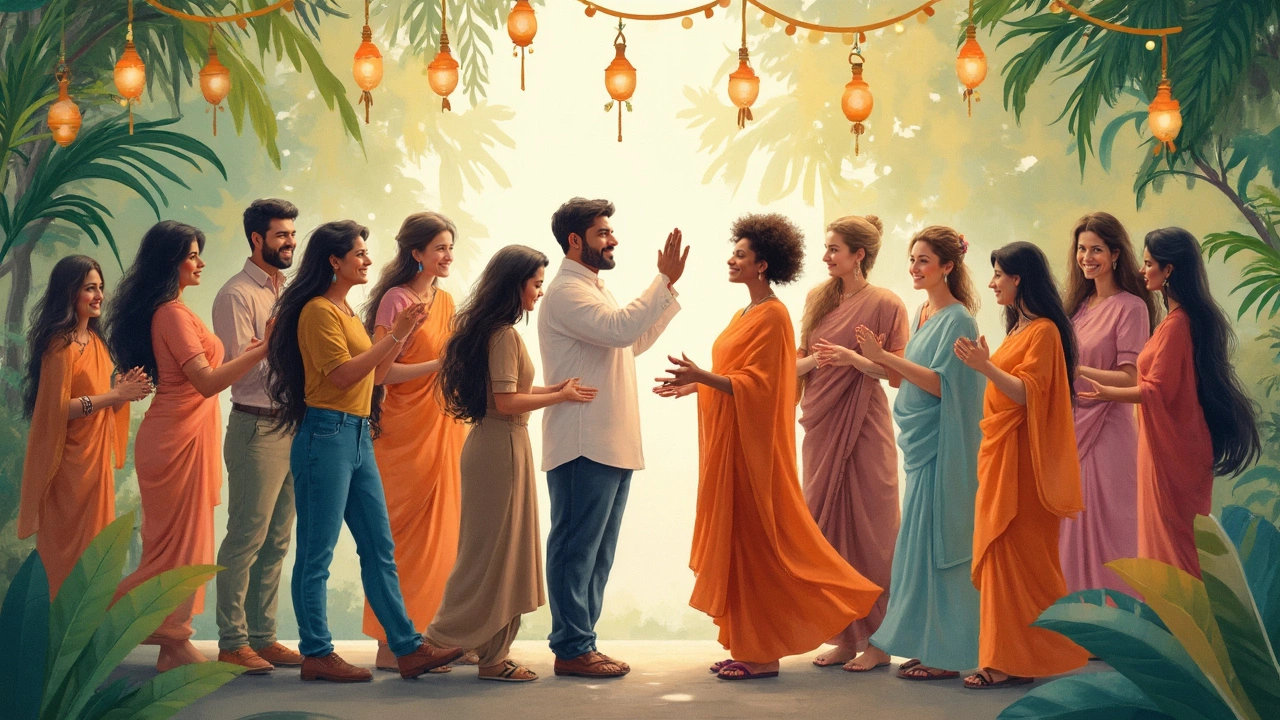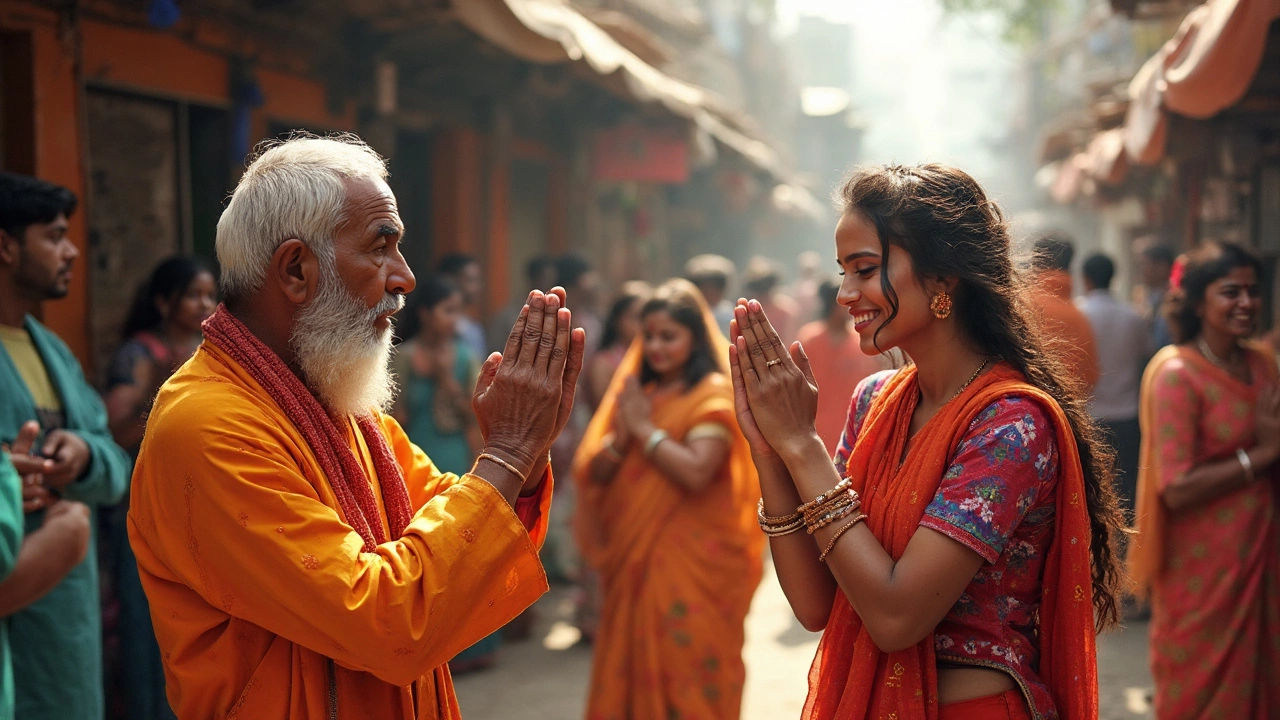So, you're about to greet an Indian woman and want to make sure you do it right. First off, it's great that you're considering the cultural aspects—it's not just about saying 'hi.' India is diverse, and how you greet someone can depend on several things like age, region, and the social context.
A common and respectful way to greet is with a 'Namaste,' where you join your palms together with a slight bow of the head. It's a gesture that conveys respect, and people across India are familiar with it. But wait, there's more than just this traditional approach.
In more urban settings, a handshake might be appropriate, especially in informal or business environments, but always wait for the woman to extend her hand first. This shows respect for her personal space and comfort.
- Understanding Cultural Nuances
- Traditional Greetings: Namaste and Beyond
- Modern Approaches to Greeting
- Body Language and Personal Space
- Respect and Connection in Greetings
Understanding Cultural Nuances
When you're in India or interacting with Indian culture, getting the greeting right can show you care. This isn't just a friendly wave or a quick 'hello'. It's a whole thing influenced by history, religion, and regional differences. India's like a quilt made up of countless unique pieces, and each piece has its way of doing things.
First up, the formal greet Indian woman situation. A lot hinges on her background—Hindu, Muslim, Sikh, or from any other community—because traditions vary. While Namaste might be the go-to for Hindus, you might use 'Sat Sri Akal' in some Sikh communities or 'Salam' for Muslim women. Knowing this can make your interaction smoother and more genuine.
Language also plays a role. With so many regional languages and dialects, the words accompanying your greeting might change. Though English and Hindi are widely spoken, a few words in the local tongue can earn you extra points. Imagine saying 'Vanakkam' in Tamil Nadu instead of Namaste—the local touch could make all the difference.
Remember, age is another factor. For elders, a greeting with more reverence, like touching their feet for blessings in some cultures, shows respect. But don’t stress too much—most people won't expect you to know every detail and will appreciate the effort.
Also, context is key. A respectful greeting in a formal office might differ from a casual family setting. In professional environments, if you’re unsure, pay attention to how others are greeting and follow suit. Observing is a great way to learn quickly.
Here’s a quick peek at how varied this can get:
| Region | Common Greeting | Common Language |
|---|---|---|
| North India | Namaste | Hindi, Punjabi |
| South India | Vanakkam | Tamil, Telugu |
| West India | Aadab | Gujarati, Marathi |
Understanding these nuances isn't just about ticking boxes; it's about showing respect and a willingness to connect meaningfully. So, keep these pointers in mind the next time you find yourself in the delightful position of greeting an Indian woman.
Traditional Greetings: Namaste and Beyond
When it comes to greeting an Indian woman, 'Namaste' is a go-to choice and a hallmark of Indian hospitality. You put your palms together in front of your chest, fingers pointing upwards, and slightly bow your head. This greeting isn’t just about words; it’s about showing respect and acknowledging the other person's presence. People often say 'Namashkar' or 'Namaskaram' depending on their regional language, but the essence remains the same.
The beauty of 'Namaste' lies in its meaning—'The divine in me recognizes the divine in you.' It's more than a greeting; it's a respectful acknowledgement, and it transcends cultural boundaries. If you're meeting someone older or in a more formal setting, a 'Namaste' is almost always appropriate.
If you're in different parts of India, greetings can vary a bit. For instance, in some northern areas, you might hear 'Sat Sri Akal,' especially in Sikh communities, as a warm greeting. In Kerala, 'Vanakkam' serves the same purpose. Understanding these little nuances can make your interactions more genuine.
Now, what about beyond traditional greetings? Well, in many urban settings, especially among younger generations, you might find a mix of traditional and modern approaches. Sometimes a simple smile and a nod accompanied by 'Hi' or 'Hello' are perfectly fine, making it essential to read the room and adapt.
On a practical note, make sure your body language matches your words. Smile genuinely, and make eye contact, but remember, personal space can vary. If unsure, err on the side of caution and stick to verbal greetings or 'Namaste' until you pick up on the comfort level of the person you're meeting. This attentiveness not only helps in making a good first impression but also shows that you respect and appreciate the diverse facets of Indian culture.

Modern Approaches to Greeting
In today's India, especially in urban areas, greetings have evolved and become a blend of the traditional and the modern. The influence of globalization and western practices is quite evident, but the essence of respect and warmth remains intact.
One of the most common modern greetings, especially among younger generations and in professional settings, is the handshake. While a firm handshake is widely accepted, it’s essential to remember that it's a personal choice for many women in India. Always let the woman initiate to show respect for her personal boundaries.
In more relaxed settings, a friendly wave or a simple "Hi" or "Hello" is often used. With the technology boom, virtual communications like video calls have also brought new ways to greet. Emoji use in chats or social media, like the waving hand or folded hands emoji, has become a gentle nod to traditional greetings while keeping it tech-savvy.
When social media enters the picture, greetings take on an even more casual tone. In a Snapchat or Instagram conversation, a GIF or a relatable meme isn't frowned upon. It's all about feeling the vibe and maintaining a connection, really.
Even as the greeting styles evolve, showing genuine respect and understanding of cultural differences remains crucial. It's not just about what you say or do, but how you make the other person feel. Embracing these modern approaches to greeting keeps interactions fresh, but respect never gets old.
Body Language and Personal Space
When it comes to greeting an Indian woman, understanding the nuances of body language and personal space can make a world of difference. Unlike some cultures where hugging or giving a peck on the cheek is a norm, India places emphasis on maintaining respectful distance, especially in formal or less familiar settings.
Body language is key. A gentle smile can set a friendly tone, but it's crucial to avoid prolonged direct eye contact if it might feel intrusive. While cultures in the West often encourage strong eye contact, in India, it's sometimes seen as overly aggressive, especially when greeting someone you're meeting for the first time.
Another important point is how you stand. Keep your posture relaxed yet attentive. Avoid crossing your arms as it might be perceived as a sign of being defensive or closed off. Instead, keep your hands at your sides or use them subtly if you're using hand gestures.
Personal space varies based on the setting. In urban areas, people might be more accustomed to close quarters, but it's still polite to respect personal space. If you're in someone's home or a close social gathering, you might notice people standing closer, but always wait and gauge comfort levels before initiating any form of physical touch, such as a handshake.
Here's a quick checklist to keep in mind:
- Smile gently to convey warmth and friendliness.
- Practice moderate eye contact, looking away occasionally.
- Avoid aggressive gestures, keep your hands relaxed.
- Be conscious of the personal space; stand at a respectful distance.
- Always allow the woman to initiate any form of physical greeting.
By paying attention to these small details, you create a comfortable environment where mutual respect can blossom. It's not just about following rules; it's about connecting authentically and respectfully with someone from a culture rich in tradition and diversity.

Respect and Connection in Greetings
When you're greeting an Indian woman, the essence lies in showing genuine respect and building a connection. It's not just about the words you speak, but also how you present yourself.
A few key things to keep in mind: the way you approach the person can say a lot about your intentions. For instance, maintaining eye contact but not staring is a sign of confidence and respect. It shows that you're focused and genuinely interested in the interaction.
Cultural sensitivity plays a big role too. Recognizing that every individual might have different comfort levels based on personal beliefs, region, or tradition is crucial. For example, in more conservative areas, it's respectful to rely on greetings like ‘Namaste’ over physical contact like handshakes.
Here’s a quick checklist to ensure you're on the right track:
- Be attentive to non-verbal signals. If someone seems a bit reserved, they might prefer a verbal greeting over physical touch.
- Adjust your greeting based on the setting. In professional settings, a nod or a handshake could be suitable, while in private gatherings, you could use a verbal greeting like ‘Namaste’ or a simple smile.
- Respect personal boundaries. Always wait for the woman to extend her hand first if you’re not sure if a handshake is appropriate.
In today's world, where cultures mix and traditions evolve, it’s easy to get confused about what’s right. But at its core, the approach remains simple: greet with respect, and you're off to a good start. Effective communication includes both words and actions, and when combined thoughtfully, they ensure a warm and respectful interaction.
